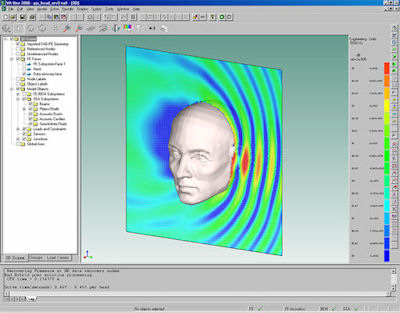Editor’s Pick: Vibro-Acoustic Simulator Updated
ESI Group's VA One update offers functionality for speech clarity assessments and engine run-ups.

Latest News
February 12, 2014
 Dear Desktop Engineering Reader:
Dear Desktop Engineering Reader:
 I’m fascinated by vibro-acoustics simulation software because some of life’s noises drive me batty—rattling car interiors, unintelligible PA systems in airplanes and so on. I know that many irksome noises and vibrations are engineering design failures or physics problems yet to be solved, and among the readers of DE is the person who will figure it out.
I’m fascinated by vibro-acoustics simulation software because some of life’s noises drive me batty—rattling car interiors, unintelligible PA systems in airplanes and so on. I know that many irksome noises and vibrations are engineering design failures or physics problems yet to be solved, and among the readers of DE is the person who will figure it out.
Anyway, lost in my December’s rush was news that the ESI Group had released a new version of its VA One vibro-acoustics simulation software. I wanted to tell you about it then but, well, life happens. Good thing it got waylaid. In the course of developing today’s Pick of the Week, I learn about yet a newer version of VA One coming out this month.
VA One is an “all-in-one” system for predicting and resolving potential noise and vibration problems upfront in the development process. This analysis and design software can couple statistical and deterministic modeling methods in a hybrid manner, letting you simulate noise and vibration across the full frequency range. It can combine, seamlessly I’m told, finite elements methods (FEM), boundary element methods (BEM) and statistical energy analysis (SEA) in a single model.
VA One is actually a suite of modules with functionalities addressing various noise and vibration simulation methods you might need. Core modules include acoustic BEM methods, acoustic FE methods, multi-pole methods, poro-elastic materials, SEA and structural FE. And of course it has a Hybrid module for creating fully coupled FE/BEM/SEA models in a single analysis.
There are extension modules for VA One as well. These include aero-vibro-acoustics, design optimization, grid solvers, scripting, shock and variance. It has modules for importing and meshing CAD data from CATIA, NX, PTC Creo (Pro/E), SolidWorks and STEP. VA One will run simulations on a laptop as well as on some big old cluster. The company says that you can create noise and vibration models in hours and get solutions in seconds rather than spending days on all of it, depending upon your platform. You’ll probably want the grid solvers to solve big BEM models in parallel across a cluster or network.
Now the update of VA One I got jazzed about. It introduced new capabilities to take into account hybrid area junctions between FE cavities and SEA panels. This means that you can better simulate small cavities like in small vehicles and you can couple BEM and FE cavities to simulate the vibro-acoustic performance of heating, ventilation and air-conditioning (HVAC) ducts. That update also brought out the ability to calculate and plot transmission loss for all sources and receivers as well as the ability to model acoustic transmission loss through walls and panels.
The newest version of VA One, 2014.0, that I just learned about offers new support for engine run-ups and other multiple load cases and a new Speech Clarity module. The new support for engine run-ups and other multiple load cases means that you can now assess the radiation profile of a powertrain under operational loads like varying revolutions per minute and throttle positions.
The Speech Clarity module is said to give you tools for computing and visualizing STI (speech transmission index) and RASTI (rapid speech transmission index) speech clarity assessments. With it engineers can do things like determine PA system intelligibility for certification purposes in aircraft. It can also help with passenger comfort in cars.
My contact at ESI Group noted that the development team is committed to bringing out two new VA One releases a year. This latest release builds off the late 2013 version, which is described in more detail in today’s write-up. The news of VA One 2014.0 is so new that details are still migrating to the ESI Group website as of this writing. However, there is a webinar coming up the first week of March on what’s new in VA One 2014.0. A link is provided to it as well as other links that should interest you.
So, hit the link and learn more about VA One 2014.0. It’s a—ahem—sound investment you could make.
Thanks, Pal. — Lockwood
Anthony J. Lockwood
Editor at Large, Desktop Engineering
Read today’s pick of the week write-up.
This is sponsored content. Click here to see how it works.
Subscribe to our FREE magazine, FREE email newsletters or both!
Latest News
About the Author
Anthony J. Lockwood is Digital Engineering’s founding editor. He is now retired. Contact him via [email protected].
Follow DE





